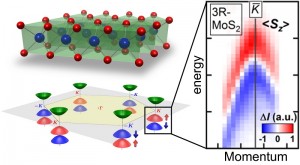A proposed valleytronics material Peculiar electronic states and their control in a 2D material

A research group lead by Professor Yoshihiro Iwasa of the University of Tokyo Graduate School of Engineering Quantum-Phase Electronics Center (concurrently team leader, RIKEN Center for Emergent Matter Science), has uncovered peculiar electronic properties of molybdenum disulfide, which has a two dimensional honeycomb crystal structure similar to graphene. The research group demonstrated that molybdenum disulfide is an extremely strong candidate material for use in “valleytronics,” a new technology for the development of low energy-consumption electronic devices based on an entirely new principle.

© 2014 Iwasa Group.
Crystal structure, electronics states, spin-resolved photoemission spectrum of molybdenum disulfide.
Recently, there have been many concepts proposed for the development of low energy consumption electronics. One of the most fundamental proposals, rather than improvements on existing technologies, is to replace electrical charge with something else to suppress energy losses as heat generated by electrical current flow. A well-known example is “spintronics,” which aims to develop the techniques for manipulating electron spin. Valley is another degree of freedom of electrons that can be found in particular materials. As its manipulation is theoretically predicted, it is attracting researchers’ attention as a new technology called “valleytronics”.
Now, the research group has uncovered a strong coupling between valley and spin. The group combined experimental data from spin- and angle-resolved photoemission spectroscopy and circularly polarized photoluminescence spectroscopy on molybdenum disulfide with first-principles calculations, and demonstrated that molybdenum disulfide possesses valley-dependent spin polarization and other characteristics required for application to valleytronics. The present results proved the theoretical prediction and are an important step toward the development of valleytronics based on molybdenum disulfide, opening the door to next-generation low energy consumption electronics.
This work was carried out in collaboration with the groups of Associate Professor Kyoko Ishizaka from the Department of Applied Physics, the University of Tokyo, Dr. Ryotaro Arita from First-Principles Materials Science Research Team, RIKEN Center for Emergent Matter Science, and Associate Professor Taichi Okuda from Hiroshima Synchrotron Radiation Center, Hiroshima University.
This research was published in the online edition of Nature Nanotechnology (28 July).
Paper
R. Suzuki, M. Sakano, Y. J. Zhang, R. Akashi, D. Morikawa, A. Harasawa, K. Yaji, K. Kuroda, K. Miyamoto, T. Okuda, K. Ishizaka, R. Arita, & Y. Iwasa,
“Valley-dependent spin polarization in bulk MoS2 with broken inversion symmetry”,
Nature Nanotechnology Online Edition: 2014/7/28 (Japan time), doi: 10.1038/nnano.2014.148.
Article link (Publication, UTokyo Repository)
Links
Graduate School of Engineering
Department of Applied Physics, Graduate School of Engineering
Iwasa Laboratory, Department of Applied Physics, Graduate School of Engineering







